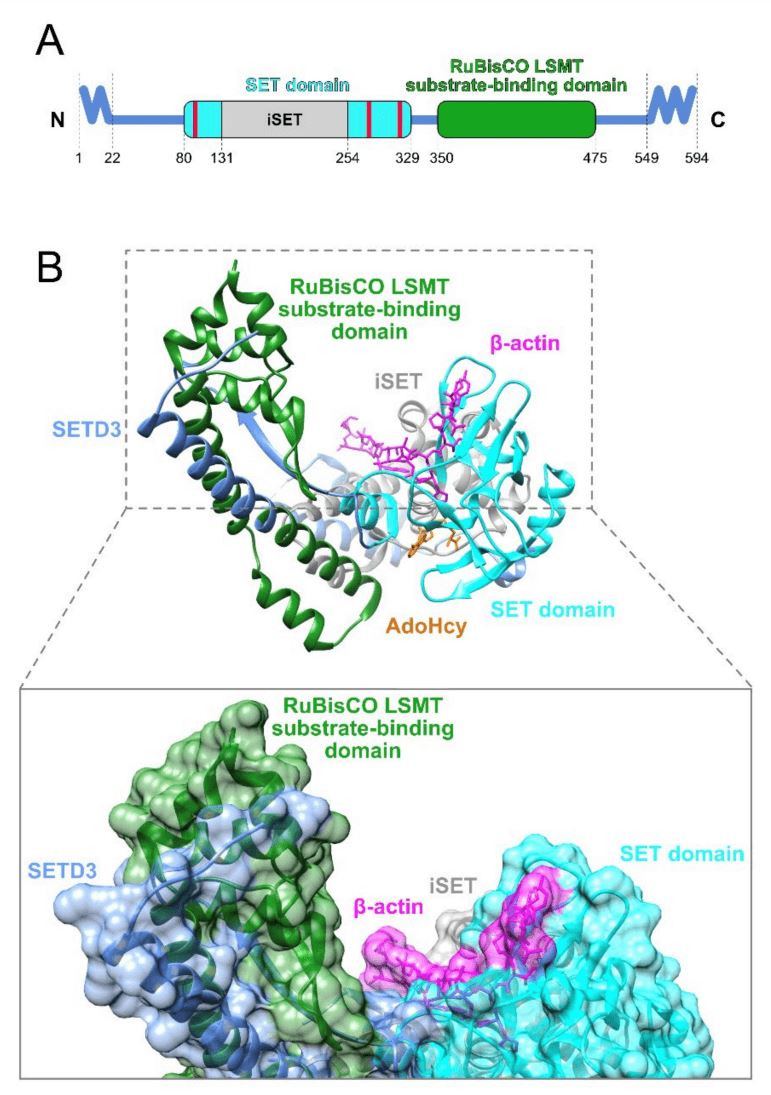In vitro diagnostic (IVD) antibodies play an essential role in disease diagnosis and therapeutic monitoring. Creative Biolabs is professional in the filed of IVD antibody development and antibody pair development. We have experienced experts and advanced platforms that enable us to provide unparalleled services targeting a panel of biomarkers. Here, we introduced the potential of SETD3 as a diagnostic marker for renal cancer.
SET Domain
As we known, genomic DNA in the cell nucleus is packaged into the nucleosome, which comprises an octamer of histones wrapped around with 146 bp genomic DNA molecule. The suppressor of trithorax (SET) domain, enhancer of zeste, variegation is first recognized as a conserved characteristic in chromatin-associated proteins and lots of SET domain-containing proteins have since been featured as a member of HMTs. Such as SUV39H1, SUV39H2, and SET9 methylate H3 or H4 and function as key epigenetic regulators of heterochromatin, genomic instability, and mammalian development. The SET domain is found in HMTs and other lysine methyltransferases. Deregulation of SET-domain function has a significant part in tumorigenesis. For example, mixed-lineage leukemia 1 (MLL1), one of the best-studied SET domain-containing proteins in human cancer, is disrupted by chromosomal translocations thereby resulting in the abnormal/aberrant expression of chimeric proteins. When it comes to other SET domain-containing proteins such as SETD2 may act as a tumor suppressor in renal cell carcinoma and breast cancer.
Introduction of SETD3
SETD3 (SET domain containing 3) is a member of HMTs with 594 amino acids length. By genomic sequence analysis, the SETD3 gene is mapped to the chromosome 14q32.2 in humans and the mouse gene of SETD3 located on the chromosome 12. Among its correlative pathways are chromatin organization and lysine degradation. Accumulated studies associated with SETD3 gene including HMTs activity (H3-K4 specific, H3K4me and H3K36me) and transcriptional coactivator activity. In mouse muscle cells, SETD3 methylates mono- or dimethylation of histone H3 Lys-4 and H3K36 and improves transcription of genes required for the cell differentiation.
Recently, SETD3 is discovered to be a well-conserved SET domain-containing protein involved in a translocation to the immunoglobulin λ light chain locus in one of the non-homologous end-joining (p53-deficient) peripheral B-cell lymphomas. A truncated mRNA lacking the sequences of a SET domain in SETD3 is highly expressed in the lymphoma. Besides, the truncated SET-less protein reveals oncogenic potential while the full-length SETD3 protein does not. Eventually, SETD3 exhibits HMTs activity on nucleosomal histone 3 in a SET-domain dependent manner. This newly identified SETD3 gene may play an important role in oncogenesis.
 Fig.1 Structure of human SETD3.1
Fig.1 Structure of human SETD3.1
SETD3 and Renal Cancer
The kidneys are bean-shaped organs located on each side of the mid back, which filter the blood and remove the water and waste in the urine. Renal cell cancer also called kidney cancer or renal adenocarcinoma, is the most common disease in which malignant cells are derived from the renal tubular epithelium. Histone methylation has been testified to implicate in renal tumorigenesis, whereas its possible clinical value as biomarker remains unexplored.
Low expression levels of SETD3, together with SMYD2 and NO66, are significantly related to the shorter disease-specific and disease-free survival, particularly in patients with non-tissue confined tumors. Referring to SETD3 expression and risk of metastization in clear cell renal cell carcinomas, scientists find that no obvious differences are apparent for gender and age between patients with clear cell renal cell carcinomas that developed metastases and those that did not.
IVD Antibody Development Service for SETD3 Marker
With extensive experience and advanced technologies, Creative Biolabs has been recognized as an expert in the field of IVD antibody development. Our scientific team is able to provide polyclonal, monoclonal, and recombinant antibody development services for diagnostic use. Besides, we help develop high-quality IVD immunoassays of different formats, giving expert support in feasibility analysis, protocol establishment, assay design, validation, and kit production. Our services are customized to suit the specific requirements of our clients.
Please contact us for more details if you are interested in our service.
Reference
- Witecka, Apolonia, et al. "The structure, activity, and function of the setd3 protein histidine methyltransferase." Life 11.10 (2021): 1040. (2022). Distributed under Open Access license CC BY 4.0, without modification.
For Research Use Only.

